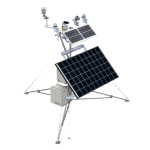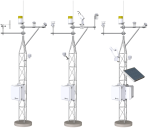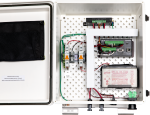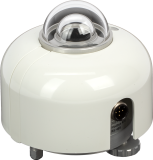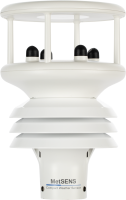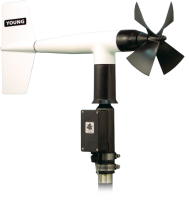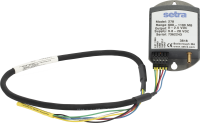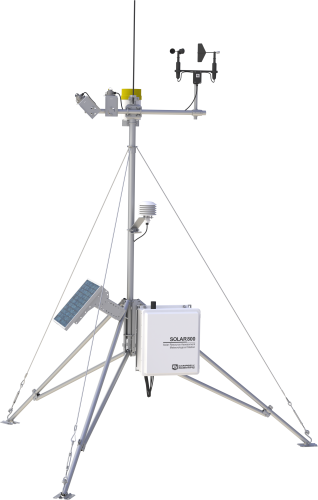
Retired Products
Fundamentals of Solar Monitoring Stations
Why are meteorological (MET) stations used in solar energy applications?
Weather and meteorological conditions are major factors that affect electrical power generation when using energy from the sun. Hence, it is important to locally monitor these conditions by measuring meteorological parameters to assess the plant operation. This is even more important for larger installations. A well-designed solar MET station will make the most accurate meteorological measurements. Solar power generation is impacted by local weather parameters, and a proper understanding of these relationships is key to ensuring that solar energy is a fiscally and environmentally sustainable source of renewable energy.
There are many components to consider for successful deployment of weather or MET stations on solar energy sites. These can include communications, data logging, power supplies, and mounting, among others. But the first consideration should always be centered around the measurements needed and selecting the best devices and sensors to make those measurements.
What are the measurements made by a solar MET station?
A wide range of meteorological parameters can have an impact on energy production, but the most important factors are irradiance—including albedo, ambient temperature, wind speed and direction, relative humidity, and precipitation—and barometric pressure. Solar MET stations often make additional measurements of panel temperature and panel soiling. A more detailed explanation follows, but the measurements and sensors used to make them are summarized in the table below:
| Measurement | Sensor Type | Example | |
Solar Radiation |
|
|
|
Panel Temperature |
Back-of-Module Temperature Sensor (PRT) |
|
|
Ambient Temperature |
Hygrometer or All-in-One |
|
|
Relative Humidity |
|||
Wind Speed and Direction |
Anemometer or All-in-One |
|
|
Barometric Pressure |
Barometer or All-in-One |
|
|
Solar Radiation
The single most important factor when determining how much electrical energy can be created by a solar installation is how much incoming irradiance is available and how this varies daily and seasonally. The sensor used for measuring the incoming irradiance is a pyranometer. Pyranometers are classified by International Organization of Standards (ISO) standard 9060, and referencing it can be helpful in choosing the correct pyranometers for an application. International Electrotechnical Commission (IEC) standard 61724-1 is used by the industry as both a standard for how to design stations for monitoring power production at solar power installations and as a guide to design stations for resource assessment. This standard recommends various classes of monitoring stations for various purposes. For collecting “bankable” data, the highest class of pyranometer is used. Bankable data is used for securing the best funding terms and monitoring contractual performance metrics. Solar MET stations often have multiple pyranometers for either redundant measurements or to measure different parameters.
Let us first define some common terminologies used in the irradiance measurements made by a solar MET station.
- Direct Normal Irradiance (DNI): If you point a sensor directly toward the sun, DNI is the light intensity collected from rays that are nearly perpendicular to the surface of the detector (directly from the sun), hence the term Direct Normal Irradiance. To view the entirety of the sun while simultaneously rejecting light from the rest of the sky, DNI sensors have a narrow field of view at five degrees.
- Diffuse Horizontal Irradiance (DHI): Light from the sun is scattered by particles in the atmosphere and clouds. This reflected and scattered light measured in the horizontal plane is called the DHI.
- Global Horizontal Irradiance (GHI): This measurement is the total solar flux available from the hemispheric sky dome. It is made by installing a pyranometer on a horizontal surface. Because the measurement includes diffused and directly incident light, it can be described by the DHI and DNI. The geometric sum of the components can be written as:
GHI = DNI * Cos(Z) + DHI
whereZis the solar zenith angle of the sun at the time of the measurement.
酥油是几乎总是一个参数测量by a solar MET station. A similar measurement called plane of array (POA) is also very common. POA measurements are made with the pyranometer detector in the same plane as the solar panel. Because POA can be calculated using GHI and station location, they are not often used in solar resource assessment. However, when the stations are installed in operational solar installations using a single or two axis trackers, it is very common to use multiple POA pyranometers to measure the light incident in the plane of the solar panels. POA can also be calculated using the GHI, DNI, and DHI measurements using the following equation:
POA = DNI * Cos(AOI) + Diffuse + Reflected
whereAOIis the solar incidence angle.
When using bifacial solar panels (solar panels that produce power from light incident on both the front side and backside of the panel), it is useful to use a complementary pyranometer to the GHI measurement. Sometimes called an albedo pyranometer, this pyranometer is mounted downward, opposite the GHI pyranometer. Because it is downward facing, there is no direct irradiation incident on the pyranometer, and it solely measures scattered and reflected irradiance. This measurement is used to provide the calculated parameter of albedo. Albedo can be monitored and used to model the light incident on the back of a bifacial module. In practice, many operating solar sites measure albedo with an albedometer mounted in a horizontal position to model the light incident on the back of a bifacial module (GReflected_back). Alternatively,GReflected_backcan be measured directly with a pyranometer mounted downward facing in the plane of array.
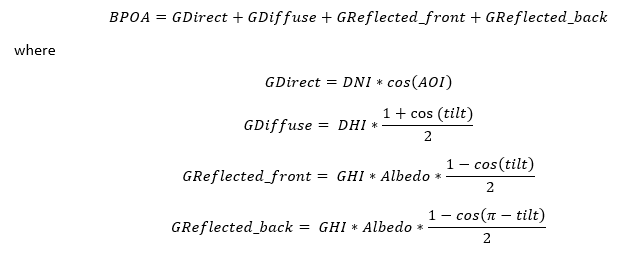
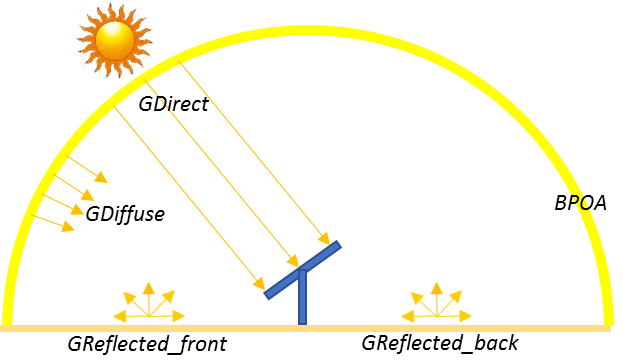
Back-of-Module Temperature (BOM)
Another important parameter on a performance assessment station is the temperature of the photovoltaic (PV) panels. PV panel manufacturers provide panel characteristics at Standard Test Conditions (STC), which consist of irradiance of 1000 W/m2and a room temperature of 25°C. The measured parameters must be converted to STC using equations suggested by IEC standards. To minimize the impact of the sensor on the measurement, small sensors are placed on the back of the solar panel using a highly thermally conductive adhesive.
Soiling Loss
Soiling measures the loss of PV power output due to the accumulation of dirt or other contaminants on the solar panel surface. Understanding soiling is critical to the design of PV systems because of the impact it has on managing PV power plant performance. Similarly, active power-generating facilities need procedures to mitigate soiling losses. Accurate measurements of soiling are important when scheduling panel cleaning to optimize revenue generated.
In addition, several ancillary meteorological parameters are also measured, such as ambient air temperature, relative humidity, wind speed and direction, and barometric pressure. Different models use these parameters in calculating the performance derating of the panels.
Where are solar MET stations used?
Solar MET stations are used in areas where solar power is being generated or in locations under consideration for such a facility. Due to the uniqueness of every solar installation, customization of the solar MET station is common; however, there are several basic categories of solar MET stations.
First and foremost are stations used for solar resource assessment (SRA). When preparing to design and install any solar power-generating facility, the solar resource available must be adequately characterized so the design can optimize the performance within the design constraints. For small installations, this can be done using a combination of satellite data and meteorological measurements from nearby ground sources. For larger sites, the high cost and site-specific nature require accurate ground measurements from the proposed site. Soiling is highly site-specific and onsite measurements are necessary for design, performance expectations, and the reduction of project uncertainty. SRA stations are purpose-built stations that make measurements in a robust stand-alone station. The quality of these stations can vary greatly, and it is best to thoroughly research the system before purchasing. These stations often include their own solar power, battery power source, and remote communication to minimize station visits during the time the SRA station is in use.
Utility-scale solar installations (20 MW to 100s of MW) are often designed and installed following the completion of a solar resource campaign. The solar resource system would be replaced by stations that are most well suited to the different requirements of a utility MET station. There are often multiple stations that form a system designed to make the measurements specific to the requirements of the solar installation. Because the information provided by the solar MET station is crucial to the operation and grid interconnection of the installation, these systems are tied to the power plant’s supervisory control and data acquisition (SCADA) system. The data provided by the MET station is required by most off-takers for accepting power onto their grid. The data logger’s ability to store data in the event of a power or network failure is an additional and important feature of a low-power MET station with an uninterruptable power source.
Smaller installations (100s of KW to 20 MW) are often referred to as commercial and industrial (C&I) stations and, despite being connected to the electrical grid, do not require the same level of monitoring. These systems are often of a size that does not warrant the complexity of a complete onsite SCADA system, but instead, feed information to a Cloud data host. In these stations, the solar MET station, in addition to making meteorological measurements, acts as a gateway with onsite data storage for meteorological, meter, and inverter data, which includes electrical power production information from these devices.
How do you select the correct solar MET station?
Selecting the appropriate solar MET station can be a daunting prospect. High-quality measurement systems are expensive to purchase, install, and appropriately maintain. However, for the value it provides, the operational cost is relatively low. It is an insignificant portion of the total cost of a solar PV farm and provides the necessary information to verify the performance of the entire installation. As Lord Kelvin, British mathematician, is quoted as saying, “To measure is to know.”
Because of the worldwide nature and interaction with the important connection to the electrical grids, the IEC established standard IEC 61724-1 for PV system performance assessment. This standard provides guidance about what is the agreed-upon best practice for designing systems for use at operational PV installations. Of relevance to solar MET station measurements, the IEC standard references ISO 9060. This separately maintained standard by the ISO provides information about pyranometers, which are a very important component of the stations. Although not all solar MET stations are used for operational purposes, many people choose to use a similar quality of system for resource assessment as they will use at an operational site.
Case standards like these are primarily used by experts within the industry, but there are other resources that are more accessible as an introduction to solar installation monitoring. The National Renewable Energy Lab (NREL) in the United States is a government-funded national lab with the directive to study and be experts in renewable energy. This information is often presented in a public forum, and you can learn more about the work NREL scientists perform and the breakthroughs they make by viewing theirwebsite. Although the NREL funds government departments such as the Department of Defense and the Department of Energy, the NREL also funds work in renewable energy through other labs. However, this work is not isolated to the United States, and similar organizations operate in many other countries.
Although these resources will educate you further about solar MET stations and the need for them, they do not design stations or provide designs or advice about which sensors to choose. Beyond the sensors discussed above, solar MET stations require data storage or data logging, mounting, power, communications, and an interface for collecting and analyzing data. Also, proper installation, commissioning, and ongoing maintenance are crucial to achieving and maintaining high-quality measurements. For assistance with choosing sensors and many of the other complex components of a solar MET station, it is often best to work with a knowledgeable and trusted consultant or hardware system expert.
Additional Resources
The following are some additional resources you may wish to review:
G. Corbellini and V. Medici, "Modelling of bifacial PV modules" presentation, University of Applied Sciences and Arts of Southern Switzerland, Department for Environment Constructions and Design, Institute for Applied Sustainability to the Built Environment, accessed December 2, 2020https://www.slideshare.net/sandiaecis/41-corbellini-analysisandmodellingofbifacialpvmodules.
F. Vignola, J. Michalsky, and T. Stoffel,Solar and Infrared Radiation Measurements, Second Edition,(Boca Raton, FL: CRC Press, 2020).
Privacy Policy Update
We've updated our privacy policy.Learn More
